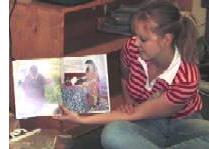|
The "Picture Walk"

Last updated Tuesday, March 19, 2002
We are generally curious beings. If we see something intriguing, we want
to try to understand it. If we hear an unusual noise, we wonder where it
came from. Children can be especially curious, since each day brings them
new experiences and new questions to be answered.
In preparing children for a read-aloud session, you can stimulate their
natural curiosity and pique their interest in a story by going through a
"picture walk." Before opening the book, show the children the cover and
read the title. Ask them what they think the story will be about, based
only on what they see.

Then slowly flip through the book, page by page, without reading a
single word. Ask them questions about each picture they see, and try
to elicit responses that require them to make inferences based upon
the images, and not the words, on each page.
"What is going on here?"
"Who is this?"
"Why does the character look so excited?"
"When is this story taking place?"
"Where did the character just come from?"
"How do you think the story is going to end?"
Starting with the five "W" and one "H" question words, you will be
able to ask plenty of questions that will engage the students'
imaginations and encourage their active participation. Vague responses
that don't give away your knowledge of the storyline, such as "That's
very possible!" or "Are you sure about that?" will plant seeds for
enthusiastic discussion while you're actually reading the book. The
students will be excited to find that outcomes they have predicted
are correct, or they will be surprised to find that the plot has
taken some unexpected turns.
Once you're done with the "picture walk" and have started the actual
read-aloud session, short discussions while you're reading can be very
beneficial to the children because they reinforce the critical thinking
that you fueled by stimulating their curiosity during the "picture walk."
Some good topics for discussion
include a testing of their storyline hypotheses ("Do you still think
the story is going to end like that? Why or why not?"), an appraisal
of the characters' actions ("Was it a good idea for the character
to do that? How would you have solved that problem?"), and an examination
of cause-and-effect relationships ("So now that you know what really
happened, why do you think the character looks so excited?").
It is helpful to moderate these discussions in a way that maintains
the smooth flow of the story and ensures that the students comprehend
the story's key points. Also, it is important that the children feel
the freedom not to participate verbally if they so wish. The less
confident children may want only to listen at this stage, and for
them, it is important to gauge their attention to be sure they are at
least mentally engaged in the discussion.
The "picture walk" can serve as a powerful tool to stir some interest
in both the story and in the read-aloud session. Not only can it
encourage the children's participation in group discussion, but it
can also improve their comprehension of the story. Providing them with
a tantalizing glimpse of visual story elements should help stir their
imaginations and help them weave an intellectual frame of reference for
better organizing and evaluating what they hear as you read the actual story.
|